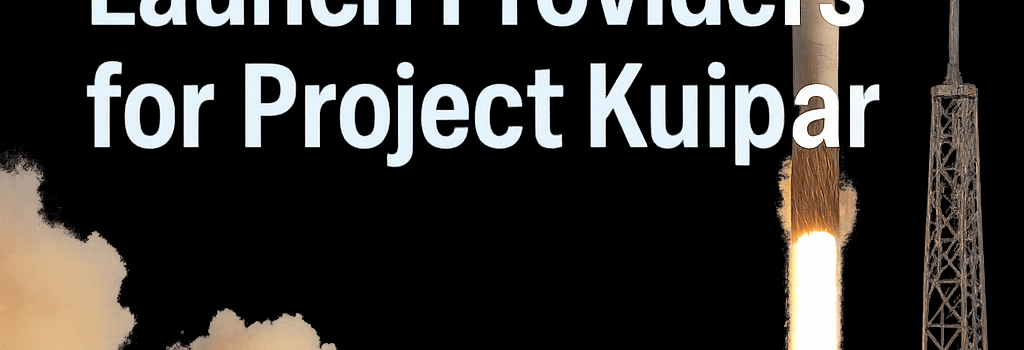Evaluating Amazon’s Launch Providers for Project Kuiper

Project Kuiper’s Ongoing Launch Campaigns
For the second time in two months, United Launch Alliance (ULA) lofted 27 broadband Internet satellites into a 450 km low-Earth orbit (LEO) on June 23, 2025. Like the April 28 mission, an Atlas V 551 rocket departed Cape Canaveral at 06:54 EDT (10:54 UTC) after resolving a ground abort related to the Russian–built RD-180 engine. The successful deployment brings Amazon’s operational Project Kuiper constellation to 54 satellites, edging closer to its 3,232–satellite target.
Atlas V Performance and Transition to Vulcan
- First Stage: RD-180 engine, dual-combustion chambers, 3,827 kN thrust at sea level
- Boosters: Five Graphite Epoxy Motors (GEM-63) SRBs, each delivering ~1,714 kN thrust
- Upper Stage: Centaur with RL10C-1 engine, 110 kN vacuum thrust, restart capability
With Atlas V deliveries concluding, ULA is pivoting to its methane–oxygen Vulcan Centaur. Each Vulcan’s twin BE-4 engines provide 2×2,400 kN sea-level thrust, and a single Centaur V upper stage (dual RL10s) can orbit 45 Kuiper satellites per launch. Amazon has booked nine final Atlas V flights, followed by 38 Vulcan Centaur missions.
Technical Deep Dive: Rocket Engines and Vehicle Architectures
Comparing propulsion systems reveals key differences:
- RD-180: Kerolox, two-chamber, single-shaft, ~835 sec Isp vacuum, heritage of 200+ flights.
- BE-4: Modern methalox design, ~330 sec Isp sea level, high throttle range, low-cost factory tooling.
- Vinci (Ariane 6): Expander cycle, ~465 sec Isp, restartable for orbital insertion.
- BE-3U (New Glenn upper stage): ~440 sec Isp, hydrogen–oxygen, limited flight heritage.
“Engine commonality and production rate will determine cadence more than pad availability,” notes Dr. Elena Cheung, propulsion analyst at AeroDynamic Insights.
Scaling Launch Cadence: Infrastructure and Logistics
Meeting Kuiper’s goal of ~25 flights per year from Cape Canaveral demands:
- Decatur Factory: Automated welding cells assembling 12 Vulcan cores/month.
- Vertical Integration Facilities: VIF-1 for Atlas V, VIF-A for Amazon-dedicated Vulcan builds.
- Mobile Launch Platforms: Two Vulcan platforms with 400 t hydraulic umbilical towers.
- Ground Systems: Upgraded telemetry, range safety radars, and propellant load lines.
Amazon’s $2 billion investment underpins build-out of launch pad 41 upgrades, second VIF, and expanded mission integration teams.
Market Implications and Competitive Landscape
SpaceX’s Falcon 9 remains the benchmark with 7,000 Starlink satellites and 5 million subscribers. Its two-day launch cadence outpaces all competitors. Amazon secured three Falcon 9 missions in 2023, with the next Kuiper batch at Cape Canaveral for a July window.
“Falcon’s proven reuse and high flight rate set the bar for LEO broadband constellations,” explains Caleb Henry, director of research at Quilty Space.
Arianespace’s Ariane 6 (two launches), and Blue Origin’s New Glenn (one flight) offer limited track records. Ariane 6 could carry ~40 Kuiper satellites post-August 2025, while New Glenn’s next window slips to 2026, constraining Amazon’s timeline.
Regulatory and Schedule Pressures
The FCC mandates 1,616 Kuiper satellites online by July 2026—half the constellation. Amazon’s delays mean an extension is probable, given its $20 billion investment and prior FCC leniency.
Key considerations:
- Orbital debris mitigation and end-of-life deorbit kits.
- Spectrum coordination with ITU and NTIA.
- Insurance premiums rising with complex rideshares.
Supply Chain and Factory Activation
Satellite production at Amazon’s Kirkland, WA facility faced teething issues: integration software bugs, thermal-vacuum chamber backlogs, and High-Speed Interconnect harness shortages. Recent throughput improvements—achieving 6 satellites/month—suggest the bottleneck is easing.
Looking Ahead: Risks and Milestones
Major upcoming events include:
- July 2025: Falcon 9 Kuiper launch #4.
- Late July 2025: Vulcan’s first USSF mission, validating BE-4 reliability.
- Q4 2025: Ariane 6 Kuiper deployment and New Glenn’s multi-payload rideshare.
Amazon and its partners must synchronize satellite production rates with rocket availability. If all goes to plan, Project Kuiper can match Starlink’s early momentum; if not, the next year will define viability.
Conclusion
Amazon’s bold commitment to multi-provider launches—involving ULA’s Atlas V and Vulcan, Arianespace’s Ariane 6, Blue Origin’s New Glenn, and SpaceX’s Falcon 9—represents an unprecedented logistics challenge. Technical maturity, factory readiness, and regulatory flexibility will determine whether Project Kuiper can truly go head-to-head with Starlink.